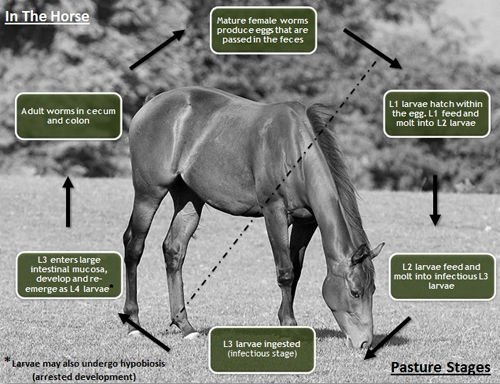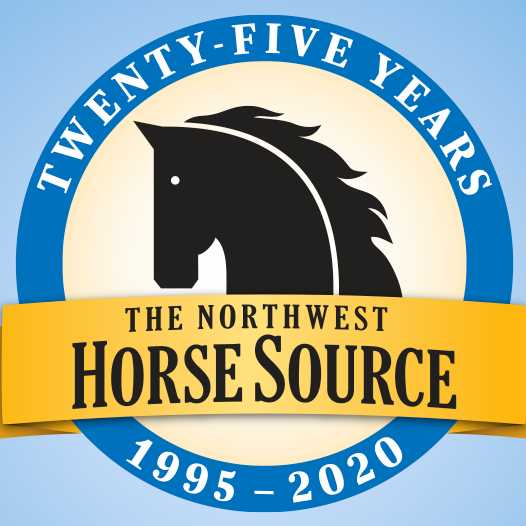By Stephen Flynn
September 8, 2015 — With strongyles posing the greatest parasite risk to horses it is important to understand how the environment factors into their development. Regardless of the time of year, it is always a good idea to have a Fecal Egg Count done on a regular time basis to ensure proper control, prevention, and treatment measures are in place. Horseman’s Laboratory is ready to service those needs.
Strongyles have a wide range of acceptable climates; they thrive best, in warmer, more humid areas. This is why warm areas with plenty of rain to grow good grass is the best place for the life cycle of small strongyles to be completed. They can survive outside throughout the colder months, even long periods of freezing temperatures hatching when the temperature reaches 7c (44F) with the ideal temperature range being between 77F to 91F (Handbook of EQUINE PARASITE CONTROL, by Dr. Craig R. Reinemeyer and Martin K. Nielsen).
 Small Strongyles, the most common intestinal worm have three stages, the third being the most critical to the parasite’s survival. At the third stage the worm is protected by a thin membrane, but has no mouth (Horsetalk.co.nz). It is at this stage the larvae are at their most vulnerable. During the hotter months the energy stores are consumed at a faster rate leaving the larvae susceptible to death by starvation. Colder months allow the larvae to burn the calories at a much slower rate so they last longer (Briggs, 2004). It may be a good recommendation to have Horsemen’s Laboratory do a Fecal Egg Count at seasonal changes. Once an owner has established which category their horses fit into by doing fecal egg counts they may only need to check the low shedders 2 times a year while checking high shedders 4 times a year. It has been demonstrated that 80% of the pasture contamination by strongyle eggs is from the 20% of the herd that are high shedders while the 80% of the herd that are found to be low shedders account of only 20% of the contamination.
Small Strongyles, the most common intestinal worm have three stages, the third being the most critical to the parasite’s survival. At the third stage the worm is protected by a thin membrane, but has no mouth (Horsetalk.co.nz). It is at this stage the larvae are at their most vulnerable. During the hotter months the energy stores are consumed at a faster rate leaving the larvae susceptible to death by starvation. Colder months allow the larvae to burn the calories at a much slower rate so they last longer (Briggs, 2004). It may be a good recommendation to have Horsemen’s Laboratory do a Fecal Egg Count at seasonal changes. Once an owner has established which category their horses fit into by doing fecal egg counts they may only need to check the low shedders 2 times a year while checking high shedders 4 times a year. It has been demonstrated that 80% of the pasture contamination by strongyle eggs is from the 20% of the herd that are high shedders while the 80% of the herd that are found to be low shedders account of only 20% of the contamination.
Another environmental factor with a hand in the worm population is the grazing land. Horses tend to divide their grazing area into 2 distinct areas. One area is known as the lawn and the other as the rough. The lawn is where most horses graze while the rough is where they pass their stool. The rough naturally contains the most eggs and infective larva. The eggs hatch and develop into the third stage infective larva in 3 days, after being passed in the horse’s stool, at which time they leave the manure pile and only travel about 18 inches and climb up the grass and wait for a horse to eat them. Since most horses do not normally graze the rough areas they are somewhat protected from the bulk of the infective larva; however man and nature often disturbs the roughs spreading the infective larva into the lawn or grazing areas. Nature does this by raining and the naturally flow of the water. Owners spread the infective larvae when they drag or mow the pastures. Dragging and mowing of pastures should be done during the hot dry part of the day. The rough areas have the longest grass due to the nutrients in the manure passed there and the retention of moisture by the manure. A few horses may not be able to resist the temptation to graze in the rough areas and this may be one reason for the disparity in the fecal egg counts of horses in the same pasture.
All in all it seems pertinent to be aware of the ideal times for parasite development, spring and fall, and parts of summer in some areas of the United States. Doing Fecal Egg Counts should never be removed from the equation. In preparation for those ideal growth times, horse owners should possibly consider plans to contact a veterinarian or Horsemen’s Laboratory on a regular basis to determine which horses in their pastures are low, medium, and high shedders by doing fecal egg counts.
This article was written by Stephen Flynn for Horsemen’s Laboratory. Stephen Flynn is a freelance writer who served in the U.S. Army and is now retired. He graduated from American Intercontinental University with a Master’s Degree.
References:
What about the Weather, Horsetalk.co.nz, Jan. 18, 2013 http://horsetalk.co.nz/2013/01/18/weather-and-parasites/#axzz3jJFWavSY
Strongyles: The Worst of the Worms, Karen Briggs, April 2004 http://www.thehorse.com/articles/14574/strongyles-the-worst-of-the-worms
Handbook of EQUINE PARASITE CONTROL by Dr. Craig R. Reinemeyer and Martin K. Nielsen

News from the horse industry. Sharing today’s information as it happens. The Northwest Horse Source is not responsible for the content of 3rd party submissions.





